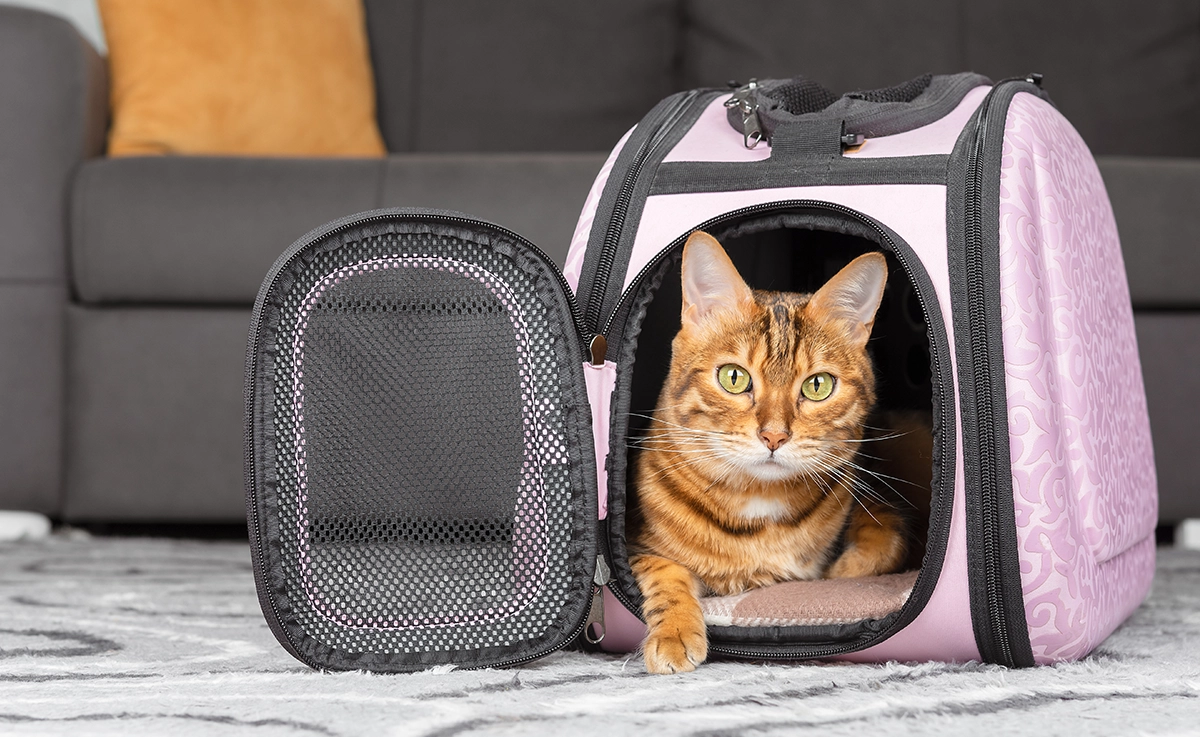
Whether it’s a visit to the vet or a weekend getaway, having the right carrier is essential. But beyond just keeping kitty contained, choosing the right size carrier size is crucial for your cat’s comfort and safety during travel. A carrier that’s too small can be cramped and stressful, while one that’s too big can leave your cat feeling insecure and jostled around.

Understanding Cat Carrier Sizes
Cat carriers come in a variety of sizes, typically ranging from small to extra large. Here’s a general breakdown of common carrier dimensions and their suitability for different cat sizes:
- Small Carriers (15″-18″ long): Ideal for kittens or small adult cats weighing up to 10 pounds.
- Medium Carriers (18″-20″ long): Suitable for most average-sized adult cats up to 15 pounds.
- Large Carriers (20″-24″ long): Perfect for larger cat breeds or hefty felines weighing over 15 pounds.
- Extra Large Carriers (over 24″ long): Accommodates cat breeds like Maine Coons or multiple smaller cats traveling together.
Remember, these are just general guidelines. Breeds can vary greatly in size, so it’s always best to measure your cat for the most accurate fit. Here’s how to measure your cat for a carrier:
- Length: Measure your cat from the base of the tail to the tip of the nose while they’re standing upright.
- Height: Have your cat stand on a flat surface and measure from the top of their head to the base of their front paws.

Carrier Material and Design
Beyond size, the material and design of the carrier also play a key role in your cat’s comfort and travel experience. Let’s explore the pros and cons of different carrier types to help you decide which one best suits your feline adventurer’s needs:
- Soft-sided carriers: Lightweight, portable, and often more comfortable for cats. However, they may not be ideal for very squirmy felines or airline travel.
- Hard-sided carriers: More sturdy and secure, good for nervous cats or airline travel. They can be heavier and bulkier, though.
- Backpack style: These carriers often have a large plastic bubble to give your cat a wide view of their surroundings while being easy for you to carry.
- Cat strollers: This style might sound whimsical, but they are a great option if you enjoy taking your cat with you on short trips. Some pet strollers convert into carriers so you can bring them in the car without much hassle.

Features to Look For in a Cat Carrier
There are other important factors to consider when choosing a carrier for your cat. Extra features make all the difference to guarantee a smooth and stress-free journey, whether it’s a quick visit to the vet or a weekend trip. Some of our top considerations include:
- Your Cat’s Personality: Is your cat on the shy side? A carrier with a hiding spot or covered top might be ideal.
- Ventilation: Proper air circulation is vital for your cat’s comfort. Look for a carrier with mesh panels on multiple sides, allowing for fresh air and preventing overheating.
- Durability and Security: Look for a carrier made from sturdy materials with secure closures to prevent escapes. A secure escape-proof door is essential to prevent your feline Houdini from making a daring mid-journey jailbreak. Look for sturdy latches or locking mechanisms that your cat can’t pry open. Double zippers with zipper covers are a good option for added security.
- Ease of Use: Consider a top-loading carrier for easy access and a comfortable carrying handle or strap for you. Choose a carrier with a removable, washable liner or interior that’s easy to wipe clean. A leak-proof bottom is a bonus for unexpected messes.
Travel Needs
If you’re planning a trip with your cat, the distance you’ll be traveling with your feline friend also impacts your carrier choice. Traveling with your cat can be an adventure, but it’s important to make sure they feel comfortable and secure during the journey. Considering a road trip with your cat? Look for a larger carrier or a wire pet crate with features like a built-in water dispenser or a litter box attachment.
If you’re planning on flying with your cat, be sure to check your airline’s specific regulations for pet carriers. These regulations can vary, so it’s important to plan ahead to ensure your carrier meets their requirements.

Training Your Cat to Use the Carrier
For a stress-free travel day, introduce your cat to their carrier long before the vet or trip. Introducing a carrier just before a trip can cause extra stress for both you and your feline friend. You can even turn your cat’s carrier into a happy place when relaxing at home. Here are some tips for making the carrier a positive experience for your feline friend:
- Leave the carrier out in the open: Make the carrier a familiar part of your cat’s environment. Place it in a cozy spot with a soft blanket or bed inside.
- Positive reinforcement: Encourage your cat to explore the carrier by leaving treats or catnip toys inside. Reward them with praise or petting whenever they enter the carrier willingly.
- Short practice sessions: Start with short periods inside the carrier, gradually increasing the duration as your cat becomes more comfortable. A synthetic pheromone spray can also help reduce anxiety and create a calming effect.
By following these tips and carefully considering your cat’s needs, you can find the perfect carrier that ensures a comfortable and stress-free travel experience for both of you. Remember, a happy cat makes for a happy journey. With a little planning and the right carrier, you and your furry friend can embark on your next adventure together with confidence!
